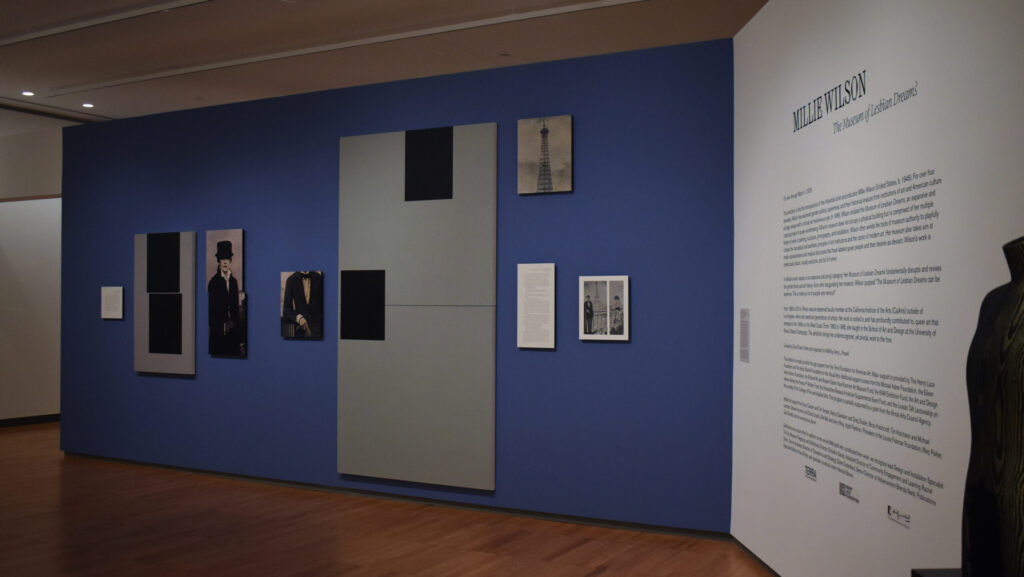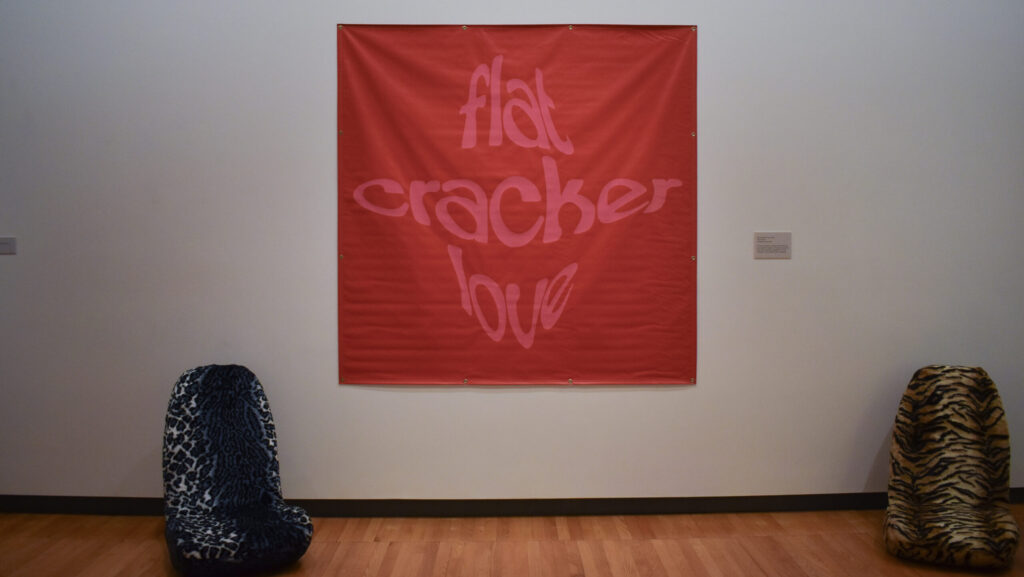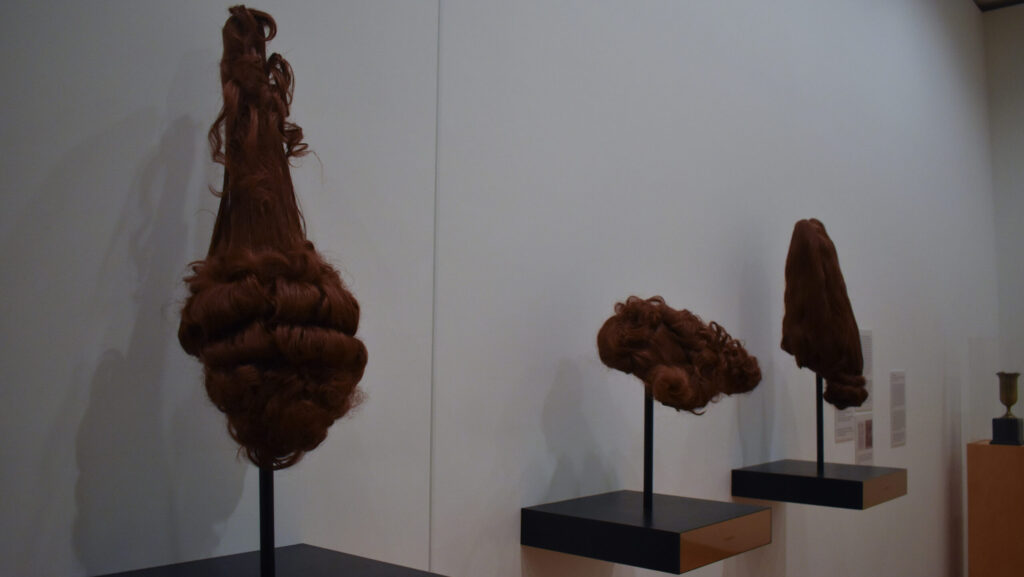CHAMPAIGN – Fantastical wig sculptures. An accused serial killer. A gathering of stuffed clothing in animal print. “Millie Wilson: The Museum of Lesbian Dreams” has it all.
The show, on display at the Krannert Art Museum in Champaign through March 1, is the first retrospective exhibition showcasing three decades of artist Millie Wilson’s work. It highlights Wilson’s significant yet previously undervalued contributions to art during the 1990s. Much of her work uses satire and fiction to challenge historical representations of gender and sexuality, which Wilson said was driven by her experience growing up as a working-class girl in Texas.
Wilson has said that the Museum of Lesbian Dreams can be anywhere — and that it makes a lot of people nervous.
“Because what am I doing?” Wilson said. “I’m colonizing everything that’s existed as museum and art. I’m going, ‘I want to be there or I want my fellow queers to be there,’ and the only way to do that is to just put yourself there and imagine yourself there and offer ways of entering into that as a possibility.”
Wilson taught painting at the University of Illinois Urbana-Champaign from 1983 to 1985 before moving to CalArts, where she influenced numerous contemporary artists. Her work is displayed in seven sections, arranged chronologically and thematically, and includes various mediums, including painting, sculpture and found objects.

The exhibition was curated by David Evans Frantz, an independent curator based in Los Angeles. Evans Frantz first connected with Wilson in 2014 and is known for recuperating underrecognized queer artists in his work.
“What you do [in a museum] is a rarity in our culture because it requires you to sit with something and look at it and think deeply, and that’s not something that any of us are wired to do in the contemporary moment,” Evans Frantz said. “Millie’s work really disarms you with humor and seduces you with beautiful objects to think deeply about these topics.”
Evans Frantz met Amy Powell at a curator convention and said she immediately understood the importance of Wilson’s work. Powell is the host curator of the exhibit and the contemporary and modern art curator for the Krannert Art Museum.
“I think we’re self-conscious as cultural workers that this work actually welcomes people who have historically been excluded from museum spaces and spaces of culture,” Powell said. “We’re unapologetic about that.”
One section of the exhibit is titled “Not a Serial Killer” and revolves around the case of Aileen Wuornos. Wuornos murdered seven men in 1989 and 1990 while supporting herself as a sex worker. Wilson examines the cultural implications of Wuornos’ actions and the media’s portrayal of her as a man-hating lesbian. Wilson said she’s faced opposition to her work.
“I’ve had hate mail, even from other feminists — I’m never the right kind of feminist, I’m never the right kind of lesbian,” Wilson said. “My gallerist at the time said, ‘Millie, why do you have to do a show about a lesbian serial killer?’ I just said, ‘I have to, so get ready.’”

Wilson hopes that even people who are uncomfortable with her work would be willing to discuss the content and meaning of her artwork.
“I would try to charm, I try to seduce,” Wilson said. “That’s what the work does really, and I would hope that the conversation wouldn’t be closed off from the very beginning.”
The space has been carefully curated by Evans Frantz and Powell, from the exact shade of color on the walls to how a viewer can move from room to room.
“There’s so much joy and eroticism just to view that material, and you can’t get that in a photograph,” Evans Frantz said.
Another section, titled “Errors of Nature,” playfully challenges the pathologization of homosexuality and gender nonconformity in mid-20th-century scientific research. One piece of artwork features three merkins, each shaped to imitate scientific drawings of vaginas. Another displays a ruler in a pink drawer — a lesbian dream that was interpreted by scientists as a subconscious reference to heterosexual intercourse.

The exhibition’s title, “The Museum of Lesbian Dreams,” is a celebration of queer world-making paired with a playful mockery of Freud’s fixation on the unconscious and midcentury sexology studies. The “s” at the end of the title has an extra tail on the top, which Powell said is for whimsy.
Evans Frantz said that knowing history and seeing that in the present is powerful and important, particularly for people who feel marginalized or attacked.
“Millie is so astute at placing herself and thinking about herself and her community into a very expansive larger history,” Evans Frantz said. “[She looks] to relationships to the early 20th century and lesbian artists that were working in Paris at the time and had a different conception than we even think about today of gender expression and sexuality.”
Powell said Wilson’s work invites people to model that everyone can be an agent of creation and community.
“Looking to one’s forebears, reading books, mining history, making community among those around us and those who have come before us – so that there’s a way forward for those who come after us,” Powell said. “I think this exhibition really models how to be.”
Wilson said she’s never planned to have a legacy with her artwork.
“One of my students said at CalArts, ‘Well, Millie, after you die, you’ll be famous.’ And I thought, ‘Okay, well, but I’m not dead,’” Wilson said. “It’s not about fame; it’s about being part of the conversation, having the work out there, having other minds and hearts touch it. It’s important to me, or I wouldn’t have done it.”
Wilson visited the show for the first time on Feb. 12. She said she felt joy and appreciation that it was done so carefully.
“I haven’t seen a lot of that work in a long time because it’s been in storage,” Wilson said. “The work has to be out of storage to function. So it was very moving, and I was just very delighted by how beautiful these two people made it.”

